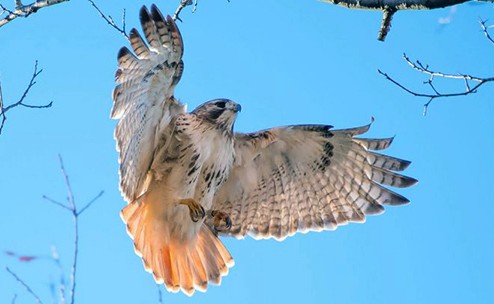
Artist David Cohen adjusts the placement of Ezra’s leg band, the same band that Ezra wore during his life, at the installation of the nesting scene he carved to honor the hawk family. Photo by Charles Eldermire.
Cornell hawk family immortalized in sculpture
By Pat Leonard
Hawks are now nesting in the atrium of Corson-Mudd Hall on the Cornell University campus. The two adult birds and one fluffy chick won’t even flinch when you move in for a closer look.
This life-size sculpture is the work of David Cohen from Cape Cod, Massachusetts, a self-professed fan of Cornell’s red-tailed hawk family. The birds are superstars on the Lab of Ornithology’s live bird cams and have been nesting on a Tower Road light pole nearly every year since 2012.
The sculptured scene represents the real female hawk, Big Red, and her previous mate, Ezra, named for university founder Ezra Cornell. The cam community was devastated when Ezra died in 2017 after sustaining injuries from a collision, perhaps with a nearby building or vehicle. For Cohen, this sculpture is a memorial based on a real-life scenario he can’t forget.
“When I decided I wanted to have a remembrance of Ezra,” Cohen said, “I started flipping through all the screen shots I had taken from the hawk cam. I found this one scene from 2016 taken shortly after the first chick hatched. Big Red is stepping back, revealing the chick, which is looking up at Ezra. This gave me the idea for the nesting scene and its name: Hello Daddy!”
When Ezra died, the outpouring of sadness from his fans included many comments about what a good dad he was – a great provider and steadfast protector of the chicks and of Big Red. That’s where Cohen, a devoted parent and grandparent, felt the emotional intersection of his own life with that of the hawks: the shared experience of parenthood. He began roughing out the sculpture in 2017 and finished it a few months ago.
Cohen says he agonized for Big Red, too, who couldn’t know why Ezra didn’t come back. After missing one nesting season in 2017, Big Red “auditioned” a new mate, Arthur, named for Lab of Ornithology founder Arthur A. Allen. Big Red and Arthur have been coming back to raise their chicks on the same light pole on campus ever since.
“This project, there was so much emotion and inspiration for it that it really carried me through the years of work, including the pandemic,” Cohen said. “I wasn’t just carving an anonymous hawk. I knew these birds. The way I think of the scene is, Ezra’s seeing that chick, perhaps for the first time. The way the light is shining, you can look in their eyes, you see the chick looking up at Ezra. I don’t know what goes through the mind of a hawk, but to me you can see his emotion.”
A sculpture of this size and complexity is not easy. The artist begins with shaping the dense tupelo wood blocks, then defines feather groups, creates layers of feathers, and adds the fine texture of every feather with wood-burning tools – a process Cohen describes as “unbelievably tedious.” The final phase is sealing the wood and painting it.
The soundtrack in his head helped Cohen get through the days, months and years it took to complete the work.
“Once the piece is designed it becomes more a matter of executing the design,” said Cohen, who is also a composer. “For me, music is 90% of my internal dialogue. My brain gets busy doing some musical thing while my eyes are working on the carving,
“One of the things that I really got from watching the Bird Cams, and why I became so enamored and addicted to them, is how much I learned about hawk nature,” Cohen said. “These are pretty intense creatures. I love them, I love their nature – the way they communicate, the way they care for their young. The more time you spend watching them, the more you realize they don’t lie to each other, they’re not hiding an agenda, they’re not trying to outdo each other – they’re just surviving. I found great inspiration in all of that.”
Corson-Mudd is open to the public via the Tower Road entrance from 7 a.m. to 5 p.m., Monday through Friday.
Pat Leonard is a staff writer for the Cornell Lab of Ornithology.
Media Contact
Get Cornell news delivered right to your inbox.
Subscribe

